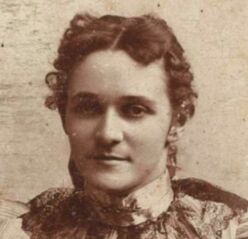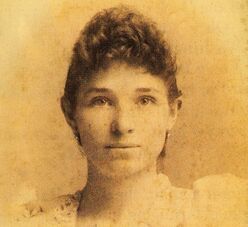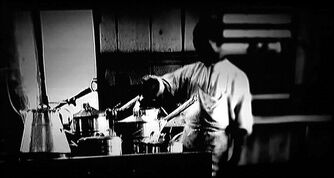The Servant Girl Annihilator, also known as The Austin Axe Murderer, is a still-unidentified ephebophilic and hebephilic serial killer and serial rapist who was active in Austin, Texas from December 1884 to December 1885. As the killings stopped three years before the murders committed by Jack the Ripper, the police did not understand at the time that they were dealing with a serial killer, and he wasn't identified as such until the 20th century.
Case History[]
In the first months of 1885, a series of brutal attacks began, targeting female domestic servants. The Annihilator's first canonical victim was Mollie Smith, who was killed on the night of December 30, 1884. Her boyfriend was also left severely injured from the attack. On March 19 of the next year, Clara Strand and her friend, Christine Martenson, were attacked by an unidentified individual and severely wounded. On May 6, Eliza Shelley, a mother of three children, was attacked and brutally murdered. Days later, Irene Cross was attacked by a man with a knife, being stabbed multiple times and left to bleed to death. During the next month, Clara Dick was found severely injured, having survived an attack. The Annihilator's next victims were Rebecca Ramey and her daughter Mary; though Rebecca survived the attack, Mary was killed. On September 1885, a man attacked Gracie Vance, Orange Washington, and their friends, Lucinda Boddy and Patsey Gibson. Lucinda and Patsey survived the attack but were left severely injured, while Gracie and Orange died.
The Annihilator's last known victims were murdered on the same night. They were identified as Susan Hancock and Eula Philips. Eula's husband, James Philips, was also attacked during the assault on his wife, but he managed to survive. The crime scenes were so bloody that the population began to ask themselves if multiple individuals or gangs were responsible for the crimes. Bloody axes and sharp objects were often left behind at the crime scenes, along with bare footprints missing one toe. Several suspects were arrested but investigators were not able to connect any of them to the murders, which angered the public. Private detectives were hired to solve the case but no one was able to identify the killer. The killings suddenly stopped after December 1885, when additional police officers and more professional investigators were hired. Because of the fact that Susan and Eula were Caucasian women, the city demanded more attention to the case but despite all the efforts, the killer was never caught and the case went unsolved.
Modus Operandi[]
The Annihilator's victims were mostly young, African-American women who worked as domestic servants, a common job at the time. They were attacked indoors while asleep in their beds, but five of them were dragged outside and killed outdoors. The Annihilator also raped and mutilated his victims; three of them were left mutilated indoors while only one victim was mutilated outdoors. Adding to the brutality of the murders, the killer would insert sharp objects in their ears. The Annihilator would also attack anyone who was present during the murders, including the victims' friends, boyfriends, and husbands but sparing children if possible.
Profile[]
In an interview with the PBS documentary series History Detectives, Mark E. Safarik profiled the Annihilator as a young, muscular African-American male, likely in his early twenties, who acted alone and felt powerless in his daily life. He would not target Caucasian females in his early crimes because he considered them too risky, but after a string of successful murders, he was emboldened to do so. He would not stop killing on his own free will; therefore, he must have been prevented from continuing the crimes by an unrelated external reason, such as being incarcerated for another crime.
A geographic profile by Kim Rossmo, interviewed in the same program, concluded that the criminal most likely worked in Congress Avenue, the nonsegregated commercial heart of the city at the time. Because the train station was there, it is possible that the killer did not reside in Austin.
Known Victims[]

Susan Hancock

Eula Phillips
Canonical[]
- December 30, 1884: Mollie Smith and Walter Spencer:
- Mollie Smith, 25 (bludgeoned with an ax)
- Walter Spencer, 30 (assaulted only)
- 1885:
- May 6: Eliza Shelley, 30 (bludgeoned with an ax)
- May 22: Irene Cross, 33 (stabbed repeatedly and died from subsequent blood loss)
- August 30: Rebecca and Mary Ramey:
- Rebecca Ramey, 50 (bludgeoned with an ax; survived)
- Mary Ramey, 11 (raped and bludgeoned with an ax)
- September 28: The attack on Gracie Vance:
- Gracie Vance, 20 (raped and bludgeoned with an ax)
- Orange Washigton, 25 (incidental; bludgeoned with an ax)
- Lucinda Boddy, 17 (incidental; bludgeoned with an ax; survived)
- Patsey Gibson, 17 (incidental; bludgeoned with an ax; survived)
- December 24:
- Susan Hancock, 41 (bludgeoned with an ax; survived, but later died from her wounds)
- Eula and James Phillips:
- Eula Phillips, 17 (raped and bludgeoned with an ax)
- James Phillips, Jr., 24 (assaulted only)
Possible[]
- 1885:
- March 19: Clara Strand and Christine Martenson (shot; both survived)
- August: Clara Dick (injured with an unknown weapon; survived)
Suspects[]

Nathan Elgin as depicted in History Detectives.
- Nathan Elgin (1866-1886)
- 19-year-old African-American cook.
- Worked close to the original crime scenes.
- Had a clubfoot with a missing toe.
- Was shot and killed by police while attempting to assault a girl named Julia with a knife for no apparent reason.
- Maurice:
- A cook from Malaysia, whose surname is unknown.
- Worked at the Pearl House Hotel, which was close to the murders.
- Was a suspect in Eula's murder and left Austin three weeks after her death.
- Sometimes identified with "Alaska", a Malay cook named as a suspect in the Ripper's murders, but whose existence is considered unlikely.
Notes[]
- During the attacks, the Servant Girl Annihilator interacted with two young boys but did not harm them. The first one was eight-year-old Douglas Brown, a nephew of Irene Cross,[1] who declared that a “big, chunky negro man, bare-footed and with his pants rolled up [sic]" had covered him with a blanket and told him to be quiet. He had no recollection of the murder and it is speculated that the killer sedated him with chloroform stolen from a dentist's home. The other child was Eula and James Phillips' two-year-old son Thomas Phillips, who was sleeping with his parents and was given an apple by the killer.
On Criminal Minds[]
- Season Four
- "The Big Wheel" - While the Servant Girl Annihilator was never directly mentioned or referenced on the show, the case appears to have been an inspiration for the episode's unsub, Vincent Rowlings - Both were serial killers who selected their victims beforehand and attacked them in their own homes or workplaces, targeted a specific type of female victim before deviating from it in their final crimes (Rowlings killed white women that resembled his mother but later murdered a black woman and finally a black man, while the Annihilator killed black women before murdering two white women), stabbed their intended victims several times (although Rowlings only delivered a single stab during his final string of murders), had one unplanned male victim that they eliminated quickly (a gangbanger in Rowlings' case, the boyfriend of one of his victims in the Annihilator's), and came in contact with the child of one of their victims but spared said child.
Sources[]
- Wikipedia's article about the Annihilator
- Website about the Servant Girl Murders
- History Detectives episode about the Annihilator's murders
- KVUE article about the Annihilator
- Texas Monthly article about the Annihilator
- Casebook: Jack the Ripper article about "Alaska"
- Find a Grave article about Nathan Elgin
References[]
- ↑ Misreported in Nigel Cawthorne's The Mammoth Book of Killers at Large as a son of Eliza Shelley.
